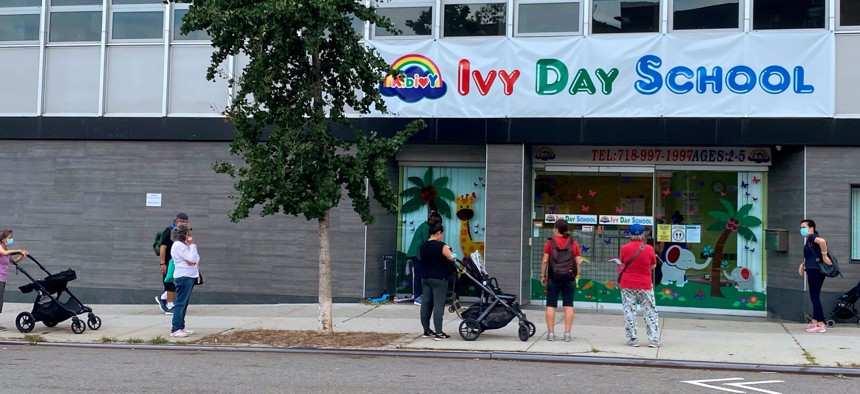Biden proposes 'historic new program' to address child care shortages

Parents waiting to pick up kids from Ivy Day School, Queens, New York. Lindsey Nicholson/Universal Images Group via Getty Images
In his budget, the president is asking Congress for more money for child care and the restoration of several pandemic-era programs, including the full child care tax expansion.
As part of his budget proposal on Monday, President Joe Biden is asking Congress to make child care more affordable for the parents of 16 million children around the country.
The president is requesting a $500 million increase in Child Care and Development Block Grant funding, which states use to lower the cost of child care for low-income families and raise child care provider wages.
But advocates say it’s not enough to stabilize the nation’s child care system, which has been teetering ever since the nearly $40 billion in child care subsidies approved under the American Rescue Plan Act expired at the end of September.
To date, more than a quarter of providers have had to cut salaries, according to a national survey by the National Association for the Education of Young Children. A similar share also reported serving fewer children. Since the subsidies ran out, advocates warned that as many as 70,000 programs could ultimately close, affecting more than 3 million children.
As a result, states like Virginia, Connecticut and Indiana have been scrambling to keep child care centers open.
Biden’s proposal would give providers some help, said Patricia Cole, senior policy director for the advocacy group Zero to Three. But it wouldn't be enough.
She applauded a separate proposal in Biden’s budget to create “a historic new program” in which households making up to $200,000 would receive subsidies to pay for child care. According to the proposal, most parents would pay just $10 a day. Low-income families would receive free child care.
The new program would mainly benefit parents, Cole said, adding that, although the administration has not released details of the proposal, it could still include much-needed funding to raise the salaries of child care workers.
To stabilize the industry, though, Cole said Congress would have to approve the $16 billion that Biden requested last year to restore the ARPA child care subsidies for providers as part of the current fiscal year’s spending. Biden is expected to continue seeking the funding as part of supplemental funding separate from the normal budget legislation. But Congress does not appear to be considering such an increase.
Cole said the child care grants could also see a slight increase in the final six appropriations bills the House and Senate are currently negotiating.
“It will not be enough to stave off the problems that the system is facing right now,” she said. “But every bit helps.”
Sen. Patty Murray, the Democratic chairwoman of the Senate Appropriations Committee, praised the proposal during a hearing on Tuesday for “tackling the child care crisis like I have long championed, so working families nationwide can find the child they care they need for about $10 a day.”
House GOP leaders, for their part, have criticized Biden’s overall budget proposal. Speaker Mike Johnson called it “reckless spending” and said it displayed Democrats’ “disregard for fiscal responsibility.” Sen. Roger Marshall, a Kansas Republican, said that while it would cut the deficit, the nation would still be trillions in debt.
“That's $16 trillion that my grandchildren will be paying interest on,” he said.
Beyond his child care proposals and calls for more funding to deal with the nation’s housing crisis, Biden’s proposal would also restore some of the pandemic aid programs that have expired.
Most notably, he wants to restore the full child tax credit expansion enacted in ARPA, which helped cut child poverty nearly in half in 2021. Biden’s proposal would also go further than what is included in the tax bill that passed the House in February and is still waiting to be taken up by the Senate. The House bill would gradually increase the tax credit from the current $1,600 until it reaches $2,000 in 2025.
Biden’s proposal would increase the credit to $3,000 per child for children 6 years old and above, and to $3,600 per child for children under 6. While those making $2,500 or less would not receive the credits under the House proposal, they would under Biden’s plan.
According to the administration, it would lift 3 million children out of poverty and cut taxes by an average of $2,600 for 39 million low- and middle-income families.
Biden would also restore another form of assistance during the pandemic to help low-income people pay their energy bills.
As heating prices reached a 10-year high last winter, Congress added an additional $2 billion in emergency funding to the $4 billion program, which covered about six million people. But that one-time funding ran out on Sept. 30. Biden’s proposal would spend $4.1 billion on the program, though states would be allowed to use some of the money to help low-income households pay their water bills.
In addition, Biden would provide more security for the Special Supplemental Nutrition Program for Women, Infants, and Children or WIC. The program faced months of uncertainty over whether it will have enough funding to last the rest of the fiscal year. The package of six appropriations bills approved last year included enough to keep the program going as food prices surged and more people than expected sought help.
Biden would provide $7.7 billion for the program, which would fund assistance for 800,000 more women, infants and children each month, providing vital nutrition assistance to nearly seven million. Should more funding be needed, the proposal would create an emergency contingency fund so that states will not have to go through the anxiety they faced this past year again.
Kery Murakami is a senior reporter for Route Fifty, covering Congress and federal policy. He can be reached at kmurakami@govexec.com. Follow @Kery_Murakami
NEXT STORY: Tips for weaving equity into opioid settlement spending






